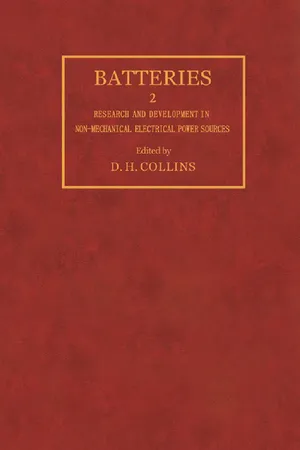
Batteries 2
Research and Development in Non-Mechanical Electrical Power Sources
- 560 pages
- English
- PDF
- Available on iOS & Android
About This Book
Batteries 2: Research and Development in Non-Mechanical Electrical Power Sources provides information pertinent to the selection and operation of power source. This book focuses on the progress and further development in battery design. Organized into 38 chapters, this book begins with an overview of the metallurgical properties of a positive grid alloy as well as the properties of dispersion-strengthened lead. This text then explains the voltage maximum as being resistance polarization. Other chapters consider the standard heat of activation for the rate-determining step at the reversible potential and explain the difficulties of predicting the orbital performance of solar cells from terrestrial measurements. This book discusses as well the chemical changes occurring during the manufacture and life of lead–acid batteries. The final chapter deals with the mechanism of the processes that occur in fuel cells. This book is a valuable resource for chemical, electrical, telecommunications, electrochemical, and automotive engineers.
Frequently asked questions
Information
Table of contents
- Front Cover
- Batteries 2
- Copyright Page
- Table of Contents
- SYMPOSIUM COMMITTEE
- FOREWORD
- OPENING ADDRESS
- CHAPTER 1. THE USE OF DISPERSION-STRENGTHENED LEAD AS POSITIVE GRIDS IN THE LEAD–ACID BATTERY
- CHAPTER 2. THE VOLTAGE CHARACTERISTICS OF A LEAD–ACID CELL DURING CHARGE AND DISCHARGE
- CHAPTER 3. OXYGEN EVOLUTION KINETICS ON LEAD DIOXIDE
- CHAPTER 4. THE POTENTIAL-pH DIAGRAM OF LEAD IN THE PRESENCE OF SULPHATE IONS AND SOME OF ITS IMPLICATIONS IN LEAD–ACID BATTERY STUDIES
- CHAPTER 5. CHANGES IN PHYSICAL CHEMICAL PROPERTIES OF SECONDARY BATTERY ELECTRODES DURING CYCLING
- CHAPTER 6. FACTORS INFLUENCING THE RETENTION OF POSITIVE PLATE ACTIVE MATERIAL IN THE LEAD–ACID BATTERY
- CHAPTER 7. THE MICROSCOPIC EXAMINATION OF ACTIVE MATERIALS FROM NICKEL–CADMIUM ALKALINE CELLS
- CHAPTER 8. THE EFFECT OF CRYSTAL HABIT AND SURFACE PROPERTIES ON THE ELECTROCHEMICAL PROPERTIES OF POROUS ELECTRODES MADE OF CADMIUM HYDROXIDE
- CHAPTER 9. INVESTIGATIONS ON THE NEGATIVE ELECTRODE OF NICKEL–CADMIUM CELLS WITH SINTERED PLATES
- CHAPTER 10. REACTIONS IN SEALED NICKEL–CADMIUM CELLS
- CHAPTER 11. KINETICS OF THE NICKEL HYDROXIDE ELECTRODE
- CHAPTER 12. THE BEHAVIOUR OF ELECTRODES OF THE SECOND KIND
- CHAPTER 13. CONSTITUTION AND ELECTROCHEMICAL REDUCTION OF γ-MANGANESE DIOXIDE
- CHAPTER 14. ION-EXCHANGE OF MANGANESE DIOXIDES
- CHAPTER 15. A DETERMINATION OF THE INTERNAL RESISTANCE OF LECLANCHÉ-TYPE CELLS
- CHAPTER 16. STORAGE OF LECLANCHÉ CELLS IN VARIOUS ENVIRONMENTS
- CHAPTER 17. THE PROBLEM OF THE PROCESSES FOR ACTIVATING MANGANESE DIOXIDES
- CHAPTER 18. RESEARCH ON THE HYDROGEN FEED MECHANISM OF A FUEL CELL ON OPEN CIRCUIT
- CHAPTER 19. PLATINUM–METAL ACTIVATION OF POROUS NICKEL ELECTRODES FOR A LOW-TEMPERATURE ALKALINE HYDROGEN/OXYGEN FUEL CELL
- CHAPTER 20. HYDROGEN AND OXYGEN IONIZATION AT THE "THREE-PHASE BOUNDARY" IN ALKALINE SOLUTIONS ON SMOOTH METALS
- CHAPTER 21. FUEL CELL ELECTRODES FOR ACID ELECTROLYTES
- CHAPTER 22. ELECTROCHEMICAL OXIDATION OF HYDROCARBONS ON A PLATINUM ELECTRODE
- CHAPTER 23. LONG DURATION DISCHARGE CHARACTERISTICS OF FUEL CELLS
- CHAPTER 24. LOW TEMPERATURE FUEL BATTERIES
- CHAPTER 25. PRESSURE OPERATION OF FUEL CELLS
- CHAPTER 26. METHANOL–AIR FUEL CELL
- CHAPTER 27. BARIUM FUEL CELL SYSTEMS
- CHAPTER 28. A RADIO-ISOTOPE POWERED BATTERY USING A KRYPTON-85 HYDROQUINONE CLATHRATE SOURCE
- CHAPTER 29. THE DESIGN AND DEVELOPMENT OF LEAD–ACID AIRCRAFT BATTERIES
- CHAPTER 30. FIELD MAINTENANCE OF NICKEL–CADMIUM BATTERIES AT LOW TEMPERATURES
- CHAPTER 31. OPERATING CHARACTERISTICS OF SEALED NICKEL–CADMIUM AND SILVER–CADMIUM BATTERIES
- CHAPTER 32. EVALUATION OF BATTERIES FOR USE IN NAVY EMERGENCY HAND LANTERNS
- CHAPTER 33. PRESENT-DAY LONG LIFE SILVER–ZINC SECONDARY BATTERIES
- CHAPTER 34. A ZINC–SILVER OXIDE CELL FOR EXTREME TEMPERATURE APPLICATION
- CHAPTER 35. SOME METHODS OF SPACECRAFT BATTERY CONTROL
- CHAPTER 36. SOLAR CELL PERFORMANCE MEASUREMENT
- CHAPTER 37. SOME RECENT IMPROVEMENTS IN THE ECONOMICS OF SOLAR ENERGY CONVERSION BY SILICON PHOTOVOLTAIC CELLS
- CHAPTER 38. ELECTROCHEMICAL OXIDATION OF ALCOHOLS